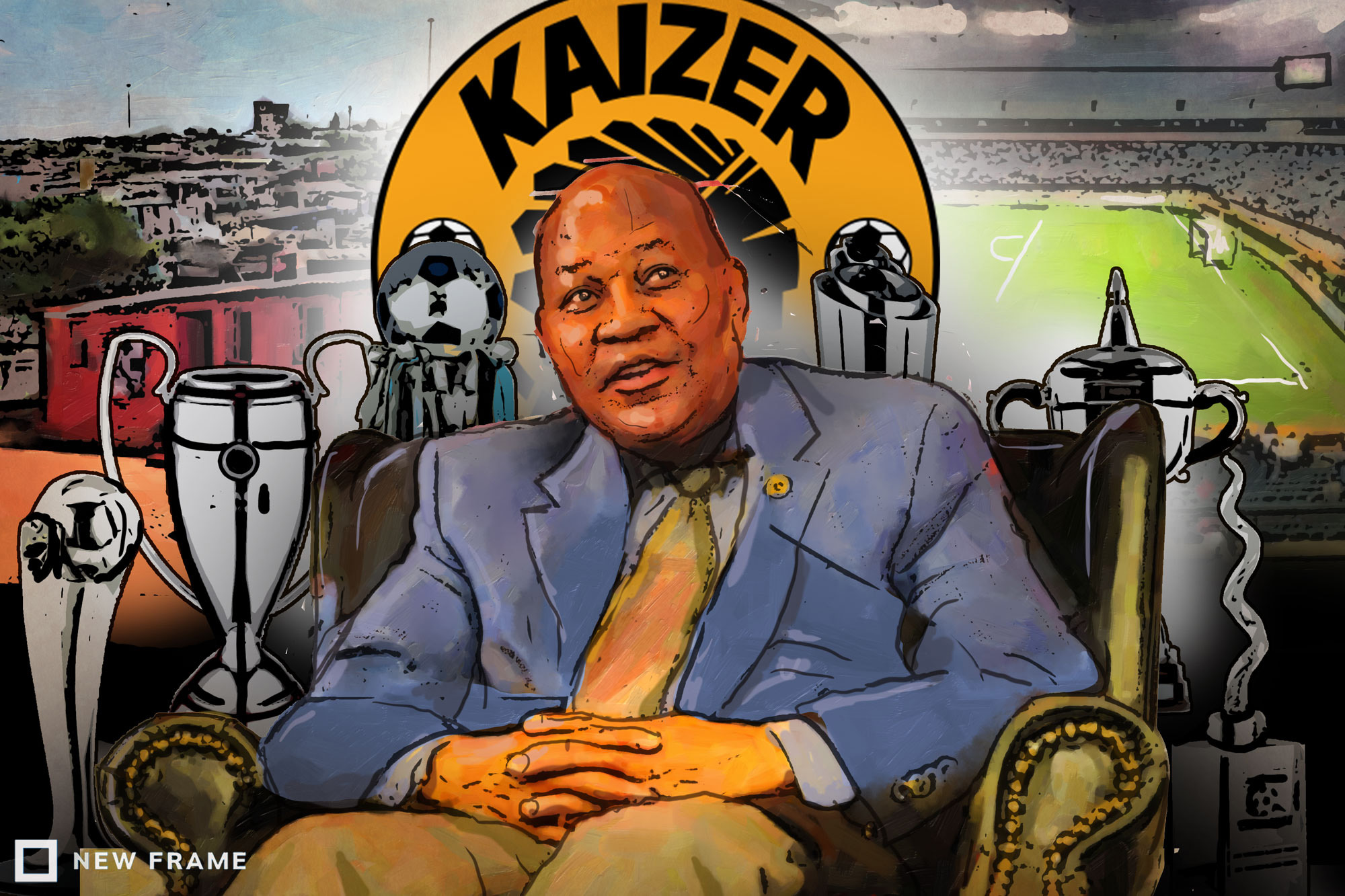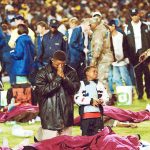What do the next 50 years hold for Kaizer Chiefs?
Amakhosi’s 50th birthday provided the opportunity to walk down a glorious and trophy-laden memory lane. But the football club’s dominance is being challenged, affecting the next 50 years.
Author:
28 February 2020

You could not set out to create a club like Kaizer Chiefs. Such a phenomenon – one that within a decade would be the biggest, richest football club in the country – is an anomaly, an instance in which circumstances were perfect at a specific millisecond in time.
One second it wasn’t there, then it was. And then it was pervasive. Beautiful and magnificent.
The remarkable story of Kaizer Chiefs, which celebrated its half-century as a football club in January, is well known because it is unique in so many ways. Few clubs around the world have been founded by a player, in this instance Kaizer Motaung, an excellent left-footed forward for Orlando Pirates from 1960 who became known by the nickname Chincha Guluva in 1969 for his fast feet. For him to then create a family dynasty is rare, too. Great African clubs such as Egypt’s Al Ahly are older and it has had 19 presidents in its 112-year history.
Related article:
In 1969, Motaung returned from his second season in the North American Soccer League – where he helped Atlanta Chiefs win the inaugural title in the United States’ fledgling league in 1968 and finish second the following year – to find four friends expelled from Pirates.
An official, Ewert “The Lip” Nene had taken the side of players Ratha Mokgoatlheng (now a high court judge), Thomas “Zero” Johnson and Edward “Msomi” Khoza in a dispute over playing an unsanctioned friendly in Botswana. Nene would go on to be instrumental as a marketing genius and zealous signer of players in the spectacular rise of Chiefs.
Borrowing some of the best club players, Motaung formed an invitational Kaizer XI that became an overnight sensation. Most significantly, Pule “Ace” Ntsoelengoe, the greatest South African footballer and US Hall of Famer who would serve Chiefs for 20 years until 1989, joined the team.
Motaung’s parents lived at 8414 Sentsho Street in Phefeni, Soweto. Low-cost housing, it was built in a 1950s style using red brick. The story goes that it was here Motaung’s father Ceyland told him to follow his instincts, making it Chiefs’ first clubhouse. Amakhosi gathered at the training field opposite the house as part of their 50th birthday celebrations in January, the place where it all began.
Motaung had seen sports teams being run as businesses in the US and wanted a club run along the same lines, where players were paid on time and treated with dignity. A team with offices, which soon they would have in upmarket Jeppe Street, defying apartheid restrictions on black businesses. A club run by a player, and not just any player.
Building a brand in tough times
The turbulence of the times – the armed struggle and civil unrest was being met with escalating police action in the 1970s, and football was just as violent – should be acknowledged. It crystalises the bravery of a 25-year-old footballer’s decision to break away from a giant such as Pirates.
Like most great football clubs, Chiefs have had its share of tragedy. Nene was stabbed to death in KwaThema in Springs in 1976 trying to sign Nelson “Teenage” Dladla from Pilkington United Brothers and captain Ariel “Pro” Kgongoane was killed by a stray bullet in the Soweto Uprising. Dladla would become a giant for Chiefs in the class of Ntsoelengoe but suffice to say, 1976 was a tough year for Amakhosi.
There were other rough years. Eliakim “Pro” Khumalo, father of Doctor Khumalo and an early player and coach at Chiefs, was shot and killed during a hijacking in 1996. The Orkney Stadium disaster of 1991 and Ellis Park disaster of 2001 claimed 85 Chiefs and Pirates supporters’ lives.
Related article:
In turbulent times, Amakhosi were viewed as upstarts. Many rival clubs thought they would be a flash in the pan. Within 10 years, they were the biggest, best run and richest club in the country. It was a story of black excellence, a glamour team who chose the colour of shining gold that glaringly opposed everything for which apartheid stood.
Vusi “Computer” Lamola was not a founding member. The brilliant midfield schemer joined in 1971 from Orlando Preston Brothers. Lamola said the class of players that Chiefs swept up, combined with Motaung and Nene’s business genius and a professionalism new to the industry, attracted sponsors and more players, which all snowballed into a breathtaking rise.
“As a breakaway from Orlando Pirates because of some grievances, they wanted to prove a point. And it worked wonders for them,” said Lamola.
“Nene was very creative and born a leader. I think it would be a grand blunder for us not to mention that he was a key founder. I’m not sure if the initiative came from him or Kaizer, but he played a vital role in the formation of Chiefs, which also led to his death.
“The approach was different. Because as we speak right now, one of Chiefs’ strengths is that they’ve got a sound administration. And obviously Kaizer is a hard worker.”
The birth of a giant
Lamola said that even in the formative years, the great South African players who bought into Motaung’s vision of a club at which they would be treated professionally saw it as a project that would last.
Motaung was an early player-coach, making the rise of his baby giant more remarkable given that he also spent much of a year playing back in the US. Lamola said Zero Johnson contributed to Chiefs’ early success as a player-coach. Joe Frickleton and Eddie Lewis brought a more English approach. Lamola left Chiefs in 1980 to form Computer Stars, which would morph into today’s Free State Stars.
When Absalom “Scara” Thindwa arrived at Chiefs from what was then Swaziland in 1985, the club was rebuilding from the founding generation.
Related article:
Marks Maponyane, Chippa Molatedi, Trevor Mthimkhulu and Wellington Manyathi were new blood to add to Dladla and Ntsoelengoe. Frickleton had overseen an enormously successful 1984, during which Chiefs swept up four trophies, but the coach who once infamously said a black team would never beat a white side had become unpopular because of his harsh training methods. Ex-player Abednigo “Shaka” Ngcobo and then Lewis finished a 1985 season in which Chiefs won just one trophy.
The innovative Romanian coach Ted Dumitru arrived via Zambia and Swaziland in 1986 to become hugely popular and successful for his understanding of the South African football playing style. Donald “Ace” Khuse, Mark and Neil Tovey, Gardner Seale, Howard Freese, Shane McGregor, Fani Madida, Lucas Radebe and Doctor Khumalo emerged to take Chiefs to even greater heights, culminating in the golden seasons of 1991 (Chiefs won three trophies, scored 84 goals and conceded 20 to win the league) and 1992 (three trophies won).
An eye for talent
Motaung’s business and football dynamism – signing the best players, finding coaches like Dumitru – and hands-on approach continued Chiefs’ success past their founding, Thindwa said.
“One season, I think in 1987, I felt I was not playing well. He called me to the office. I thought I was going to be fired. I went there shivering. When I got there, he told me I was playing well. And it was not a short talk. He wanted to know how my people were in Swaziland, if I’m happy with the situation in South Africa.
“It was not about soccer anymore. Just asking if all is well, and saying, ‘Go and do your thing.’ When I walked out of that office, I was something else.
“When I arrived, they had an office at Jeppe Street, on the third or fourth floor. When you got in there, you knew they were successful. Kaizer knew who to appoint, what players to scout. He came to Swaziland, by the way, to come and recruit me. Such energy was rare.”
It is a fact that trophies for Chiefs have slowed in each decade since the 1990s. But the journey from the red-brick house in Phefeni – where, along with Nene’s home in Diepkloof, almost all Chiefs’ early players stayed at some stage – to Amakhosi’s world-class facility at their village in Naturena today encapsulates their story.
What next?
The Kaizer Chiefs Village as a fixed asset is the rock on which the club is built today. But as Amakhosi lead the Absa Premiership title race this season, it has been notable that, despite big sponsorships and the Motaung family wealth, Chiefs seems to struggle in a player market inflated by the wallet of Mamelodi Sundowns’ billionaire owner Patrice Motsepe. Concerns have been raised over what Chiefs will become when Motaung hands over fully to his children.
Chiefs manager Bobby Motaung, who is a half-sibling to the rest of Motaung’s children, oversees the day-to-day running of the club, managing signings and hiring coaches. He has squabbled at times with his half-siblings: brand manager Jessica, digital head Kemiso and Kaizer Motaung Jr, the ex-Amakhosi striker being groomed to run the club. Criticism levelled at Bobby for the standard of players brought in and poor coaching choices, as Chiefs have gone an unprecedented four seasons without a trophy, is valid.
Lamola and Thindwa doubt that Chiefs have a cash-flow problem. Lamola is scathing about the fact that so few of his generation are involved at a board-room, coaching and scouting level.
“I don’t think their main problem right now is finance, because of so much money they have received from sponsors. I think the main problem is the guy who recruits for Chiefs,” Lamola said. “And when it comes to development, you don’t just get coaches who are going to make these guys sweat. Players must be developed more mentally than physically.”
Related article:
Lamola’s generation has not always kept up with modern training regimes and often give coaching certificates scant respect. But he is correct that fitness over individuality has become a detrimental hallmark of the Premier Soccer League since its founding in 1996.
Thindwa said Motaung, aware that he will not be there forever, allows his offspring to make mistakes.
“I think it’s a mistake to say they cannot compete financially with Sundowns. If you look at the sponsorships – Hollard, Vodacom, Toyota – they have always had money.
“But I remember, I went to speak to Kaizer because I felt the team was not doing well. He told me that he refuses to pay the amount of money that clubs are paying for players now. It’s a principle. Hence he was planning to develop players [Chiefs have invested heavily in their academy]. That route is going to take some time to see results.
“The other thing I think is happening is he’s given the children an opportunity to run the club. I asked him, ‘But surely Bra K, sometimes you must try and intervene?’ He said, ‘But how are these children going to learn if each time they make a mistake I intervene?’”
Will the barren run end?
Under a coach in Ernst Middendorp – the often foul-tempered German who sometimes appears intent on alienating South African football with statements that come across as arrogant, and whom most Chiefs supporters do not feel is of the class of their team – Amakhosi have surprisingly led the premiership. But recent weeks have severely dented the club’s chance at reversing its barren spell.
A home defeat against Maritzburg United saw defending champions Sundowns and third-placed Pirates cut the lead from nine to four and six points. Chiefs meet Pirates in a gigantic Soweto derby at FNB Stadium on Saturday 29 February where, if they lose, a team already under pressure to end almost five years without silverware and win the league in its 50th birthday season might have only a one-point lead.
If the cracks have shown again under Middendorp, they have been there for longer than the coach’s arrival a season ago. A league title in 2019-2020 might paper over them for a while, but there are clear challenges as the club enters its next 50 years. How Chiefs respond will determine if it remains the country’s biggest club when it turns 100 in 2070, or even still be in existence.




